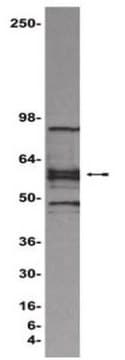306-05F
Human Cardiac Fibroblasts: HCF, fetal
Sinonimo/i:
Cardiac Fibroblasts, Fetal Cardiac Fibroblasts, HCF Cardiac Fibroblasts
About This Item
Prodotti consigliati
Origine biologica
human heart (normal)
Livello qualitativo
Confezionamento
pkg of 500,000 cells
Produttore/marchio commerciale
Cell Applications, Inc
Modalità di accrescimento
Adherent
Cariotipo
2n = 46
Morfologia
fibroblast
tecniche
cell culture | mammalian: suitable
Malattie correlate
cardiovascular diseases
Condizioni di spedizione
dry ice
Temperatura di conservazione
−196°C
Descrizione generale
Cardiac fibroblasts are the most prevalent cell type in the heart, making up 60-70 % of all cells. HCF from Cell Applications, Inc. provide an excellent model system to study many aspects of human heart function and pathophysiology.
HCF has been utilized in a number of research publications, for example to:
- Determine that electrical coupling between cardiomyocytes and fibroblasts is mediated by large-conductance Ca2+-activated K+ channels that can be stimulated by estrogen receptor agonists (Wang, 2006, 2007); and show that antimitogenic effects of estradiol on HCF growth are mediated by cytochromes 1A1/1B1-and catechol-O-methyltransferase-derived metabolites (Dubey, 2005)
- Show that in response to mechanical stretch, cardiac fibroblasts release TGF-β which causes trombomodulin downregulation, increasing the risk of thromboembolic events (Kapur, 2007) and also induces cardiac fibroblast differentiation into myofibroblasts via increased Smad2 and ERK1/2 phosphorylation, that could be stimulated by endothelin-1 and inhibited by Ac-SDKP (Peng, 2010)
- Demonstrate that activation of G protein-coupled receptor kinase-2 (GRK2) prevents normal regulation of collagen synthesis in cardiac fibroblasts mimicking heart failure phenotype (D’Souza, 2011); identify FGF2 signaling pathway as potential target for modulating apoptosis in cardiac pathology (Ma, 2011) and investigate the roles of scleraxis (Bagchi, 2012) and AMPKα1 (Noppe, 2014) in scar formation following myocardial infarction
- Show that the KATP channel opener KMUP-3 preserved cardiac function after myocardial infarction by enhancing the expression of NO synthase and restoring MMP-9/TIMP-1 balance (Liu, 2011)
HCF were also shown to express delayed rectifier IK, Ito, Ca2+-activated K+ current (BKCa), inward-rectifier (Kir-type), and swelling-induced Cl- current (ICl.vol) channels (Yue, 2013).
Origine della linea cellulare
Applicazioni
Componenti
Nota sulla preparazione
- 1st passage, >500,000 cells in Basal Medium containing 10% FBS & 10% DMSO
- Can be cultured at least 8 doublings
Mantenimento delle subcolture
Esclusione di responsabilità
Codice della classe di stoccaggio
11 - Combustible Solids
Classe di pericolosità dell'acqua (WGK)
WGK 3
Punto d’infiammabilità (°F)
Not applicable
Punto d’infiammabilità (°C)
Not applicable
Scegli una delle versioni più recenti:
Certificati d'analisi (COA)
It looks like we've run into a problem, but you can still download Certificates of Analysis from our Documenti section.
Se ti serve aiuto, non esitare a contattarci Servizio Clienti
Possiedi già questo prodotto?
I documenti relativi ai prodotti acquistati recentemente sono disponibili nell’Archivio dei documenti.
I clienti hanno visto anche
Protocolli
Culturing HCFs from human heart ventricles involves critical steps for studying cardiac-related conditions.
Il team dei nostri ricercatori vanta grande esperienza in tutte le aree della ricerca quali Life Science, scienza dei materiali, sintesi chimica, cromatografia, discipline analitiche, ecc..
Contatta l'Assistenza Tecnica.








